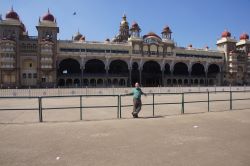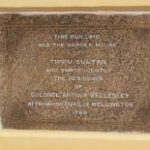Associate Professor of Business Administration Fred Hoyt traveled to India for a Faculty Development in International Business program.
Mysore in Bangalore
I am pretty sure I am in India because:
a) My GPS says I’m 8000 miles from home, at 12 degrees north, 70 some degrees west, or something like that.
b) My body feels like it’s been in the air for about 26 hours. I know it will get here sometime to join me. Hopefully soon.
c) It’s 32 degrees outside, but that’s Celsius, not Fahrenheit.
d) The main crops are coconuts and sugar cane, with evidence of rice fields.
e) Traffic is developing-country level—I spent 4 hours getting from Mysore to Bangalore (about 100 miles), and that wasn’t entirely due to the presence of 4 legged animals—no elephants or camels, though a few goats, water buffalo, Brahmins (the cow kind)—and a 4 lane road that despite reminders that people should “follow traffic discipline” expanded to 6 to 8 lanes to accommodate taxis, overloaded trucks and busses, motorcycles, bicycles, and the occasional hiker.
f) I had masala dosa for breakfast (spicy potatoes in a rice pancake), eschewing roasted and baked beans—the hallmarks of a former British colony (and I’ve always suspected one of the reasons the British sought an empire—for the food).
g) There’s a yoga mat in the closet, and two do-it-yourself yoga channels on the TV.
h) I am having a hard time reading any of the official 14 languages except for English. The local one is Kanada, or something like that, but I’ve not heard anyone say “ya betcha.”
I was thinking back to my first impressions of India, formed 15 years ago, when my family and I arrived on January 1, 1997, and I wanted to know the football scores. I rushed for the Times of India (there’s that London connection again!) and found the football scores—Manchester United 1, Arsenal 0—at that time, pre internet, it took 2 weeks to find out who won the NFL playoff games (I think it was the Packers with that quarterback Aaron Favre), but it was a reminder that for the better part of two centuries, India was part of the British empire.
 Today’s visits reinforced that heritage for me. For one thing, I visited the Mysore Palace. Mysore stayed under the thumb of the British resident, who assisted the Maharajah (a Hindu ruler is a Maharajah) until Indian independence in 1947, when the new state forced all the principalities to unify—I think it was the first time in Indian history that the subcontinent was under one ruler. The Maharajah, whom the British restored in 1799, built a splendid palace on the grounds of the original one that the dynasty’s founder had erected around 1400. When that burned down after 1900, he commissioned the same architect who built the Indo-Saracen buildings in Kuala Lumpur and Bombay to spare no expense in building him something similar in Mysore. Anyone who has seen those other trappings of the raj (me, in other words) would recognize the paternity—with Bohemia crystal, Venetian cut glass, and Italian marble. It owes a lot to the Moghul influence on regal architecture, but in this part of the world—the Indian subcontinent—that was the gold standard, even though the Moghuls never came this far south.
Today’s visits reinforced that heritage for me. For one thing, I visited the Mysore Palace. Mysore stayed under the thumb of the British resident, who assisted the Maharajah (a Hindu ruler is a Maharajah) until Indian independence in 1947, when the new state forced all the principalities to unify—I think it was the first time in Indian history that the subcontinent was under one ruler. The Maharajah, whom the British restored in 1799, built a splendid palace on the grounds of the original one that the dynasty’s founder had erected around 1400. When that burned down after 1900, he commissioned the same architect who built the Indo-Saracen buildings in Kuala Lumpur and Bombay to spare no expense in building him something similar in Mysore. Anyone who has seen those other trappings of the raj (me, in other words) would recognize the paternity—with Bohemia crystal, Venetian cut glass, and Italian marble. It owes a lot to the Moghul influence on regal architecture, but in this part of the world—the Indian subcontinent—that was the gold standard, even though the Moghuls never came this far south.
A few years ago, I read a fascinating history of the East India company, which is how the British originally became involved with India. The company had its own army (in the 1790s, the governor was Lord Cornwallis, fresh from his starring role at Yorktown), and its own government until after the Sepoy mutiny (the Indians call it the first war for independence), when it became part of the British realm and Victoria added Empress of India to her titles.

 Part of the company history occurred in this area when the Maharajah of Mysore brought in a warrior named Hyder Ali, who helped the Maharajah defeat the Company; Ali’s son, in fact, deposed the Maharajah and became Tipu Sultan (sultan being one title the Muslim rulers took). The British, led by the man who later became the Duke of Wellington, aided by one of Tipu’s assistants, captured Tipu and killed him. We saw his tomb and the summer palace he built, where, surprising to me, the British kept intact his paintings depicting his victories over them. They did destroy his palace, however, and restore the ruling dynasty—who had
Part of the company history occurred in this area when the Maharajah of Mysore brought in a warrior named Hyder Ali, who helped the Maharajah defeat the Company; Ali’s son, in fact, deposed the Maharajah and became Tipu Sultan (sultan being one title the Muslim rulers took). The British, led by the man who later became the Duke of Wellington, aided by one of Tipu’s assistants, captured Tipu and killed him. We saw his tomb and the summer palace he built, where, surprising to me, the British kept intact his paintings depicting his victories over them. They did destroy his palace, however, and restore the ruling dynasty—who had 
 the guidance of a British resident.
the guidance of a British resident.
I guess I didn’t think about it, but India was the target of a number of European empires at the time the Company was making its moves. The Portuguese were early in the game, and got ousted from Goa long after Independence. The Dutch were in the area, and before the Napoleonic Wars, had Sri Lanka. And of course, the French were here as well, and French troops helped Hyder Ali defeat the English in the 1760s as part of what the Europeans called the 7 years war, but Americans—even not knowing of the battles in India between the French and British—call the French and Indian War. Now you know why!
Note: this last paragraph history lesson is inspired by the Grimm’s fractured fairy tales on Bullwinkle! Goodnite.